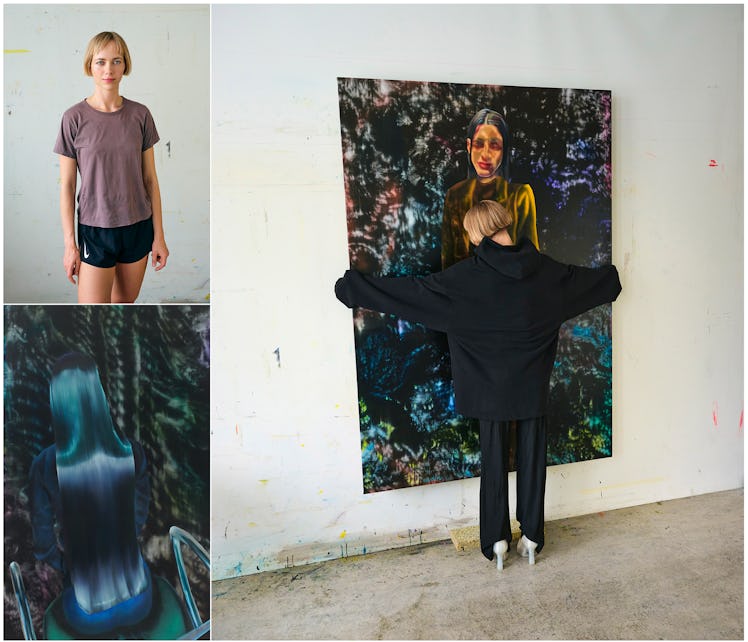Rute Merk’s Vision for the Future of Painting
In 2020, the Lithuanian artist’s surreal, figurative paintings caught the eye of Demna Gvasalia. Here, she opens up about her creative process.

For our annual “The Originals” issue, we asked creatives—pioneers in the fields of art, design, fashion, comedy, activism, and more—to share their insights on staying true to themselves. Read all of this year’s interviews here.
You make paintings that feature eerily distorted, modelesque figures resembling characters in an apocalyptic video game. But your work had no connection to fashion when Demna Gvasalia, Balenciaga’s creative director, asked you to capture his standout spring/summer 2020 collection for the Italian contemporary art magazine Mousse. That ended up inspiring an exhibition titled “SS20,” at the New York gallery Downs & Ross, for which you continued the series.
I got an email saying that Demna had come across my work, and at first, it was funny; they asked how I make my images. I’ve incorporated a photographic quality into my work for the past few years, and they didn’t know they were paintings. They wanted me to interpret the collection for a magazine, and to do it very quickly. So when we discussed the technical aspects, I was like, “This is all painting, guys. It takes a lot of time—a long time just to dry.”
And yet you delivered six paintings, capturing both the pieces in detail and the set, a makeshift parliament, within two months.
I don’t usually do collabs, but I really wanted to do this one—especially because Demna is Georgian. I come from a small town in Lithuania, and I totally recognize some of the things he designs from my childhood: the trendy jeans, the ugly shoes—it’s crazy. And then when Balenciaga said something like, “We feel there’s a relationship between your work and ours—the relationship between humans and technology,” I totally agreed. I think there is something about the synthetic construction, the inevitability of artificiality. Everything is artificial, but Balenciaga combines this ugliness and scariness in a way that makes it not so scary.
What does originality mean to you?
It’s something that catches my eye, that doesn’t look generic. It has some virtue in it, and it’s somehow noble. It’s a little bit like an instinct. I try to be original—who doesn’t? As artists, everyone is trying to run away from clichés.
What do you think is your most original trait?
It isn’t original to be a painter, but at its best, it’s a unique attempt, right? The best part of being an artist is being able to swim in your delusions and play with the mix of elements that other people have used. What we were taught in art school was trying to create something new, something that wasn’t already painted. To me, it was very important to find a visual language that would somehow correspond to the 21st century—something you wouldn’t mix with a painting from 100 years ago.
What are your delusions? What do you think about when you’re painting, or starting to paint?
I think that if you’re 100 percent realistic about your capabilities, about what life will bring to you, then there’s no way for you to achieve anything. You need a certain amount of delusion. I don’t want to indulge insanity—there has to also be control. It’s very important to be grounded. Artists have this great imagination, right? They can have this visionary way of thinking, but that can also sometimes come back to bite you. You start to deny things and ignore reality.
How do you find that balance?
With my family. My parents are doctors. They’re very practical. There were no artists in my family when I was growing up.
Whom do you consider to be original?
Someone who manages to have an authentic way of life and really changes the status quo, like Greta Thunberg. She’s too young to copy anyone, you know? And in art, well, Jan van Eyck, who popularized oil paint.
Do you have a style icon?
Whitney Houston. She was very inspirational to me growing up. But what I wear on a daily basis is really not inspired by anyone; it’s just very practical for being in the studio. I put a lot into my paintings, so there’s not much left in myself in terms of expression.
What’s the most prized possession in your closet?
I got a black T-shirt emblazoned with Barack Obama and Joe Biden, commemorating the 2009 inauguration, passing by a secondhand shop in Munich—one of those 1 euro things they keep outside in the street. I don’t even wear it, because I try to preserve it. But when I do, I feel like I’m the most dressed up.